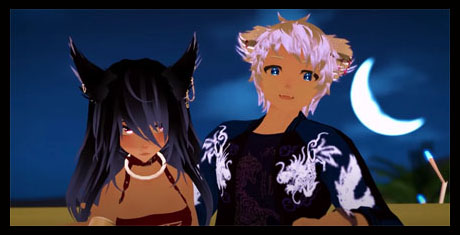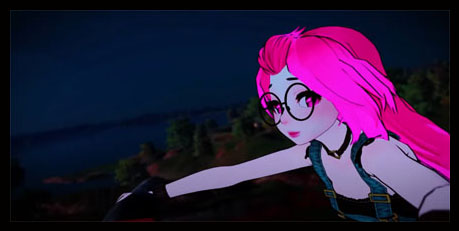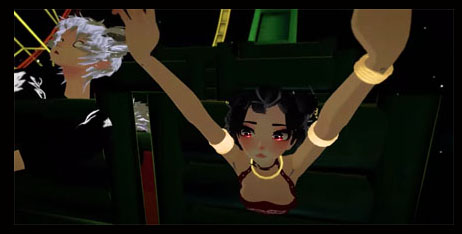
Director Joe Hunting’s fascinating and powerful new documentary We Met in Virtual Reality was filmed entirely in VRChat. Hunting introduces us to compelling subjects and a dazzling world. The future is now. We Met in Virtual Reality premieres tonight at 9pm on HBO and is also now streaming on HBO Max. Hunting discusses the film’s technological and emotional journeys in this spoiler-free Animation Scoop Q&A. (This interview was edited for length and clarity.)
Jackson Murphy: From a design / visual / animation perspective, what blew you away about being able to go inside VRChat and what you were able to experience while making this movie?
Joe Hunting: Oh, that’s a great first question. I think fundamentally being able to embody an avatar in full body tracking (look down and see your movements captured in real time) and to feel that level of immersion that you get to experience inside a VR world is certainly the most, and still is, inspiring thing about the technology. But taking that further, looking over my camera display that I’m holding and seeing my subjects also in full body tracking and feeling this intense tangibility that we’re both in this world together and we’re seeing our body and verbal languages as 3D avatars… fundamentally is extremely powerful. That’s what inspired the film and made it special during production.

JM: You talk to a lot of special people — very positive and open. Were you surprised by the people you met and just how open and positive they were? It makes the overall experience of watching the movie even better.
JH: Yeah, I was surprised. That’s why they’re in the documentary. I met all of the subjects — the heroes of the film — in different ways and the decision to include their stories and share their words on screen is really because they’re such strong speakers… not only to people who have known VR and have been inside of virtual reality before but also to audiences who’ve never tried it and are learning about it for the first time. They’re such warm, relatable voices that I knew people could enjoy them from all walks of life. That was something that made me choose their words for the documentary.

Joe Hunting
JH: I’m so glad that you think Jenny is incredible. She would be extremely happy to hear that.
JM: And I love the scene in the theme park with Dust Bunny and Toaster. Did you know as all of that was happening that you were going to use it in the movie? It’s a special scene.
JH: Yes, I did know it was going to be in the documentary. I had captured this gorgeous, drunken live performance of the song “Riptide” in a party with Dust Bunny and Toaster, and I wanted imagery to play with that. I wanted to see them on a date. So I asked them, “What do you do on your dates?” And they go, “World hopping.” They go all across VRChat exploring the different worlds, and I thought, “Let’s go to a theme park world.” I went on all of the rides with them, and we had a great time filming and getting really motion sick. And I wanted that moment to play over “Riptide”. I did know that. There were many other scenes in the documentary which I never knew would be in the film and didn’t know where they would fit, but funny enough that is one I did know. It was very intentional. And it was a great moment in production.

JM: Nice. This made me think about some of my favorite movies of the past five years or so that have a lot to do with VR: Ready Player One [from Steven Spielberg] and Belle, from Mamoru Hosoda. From your perspective being in this world, how much has Hollywood gotten right and wrong about what really goes on in VR?
JH: Oh that’s a great question! I saw Ready Player One while working as a filmmaker in VR and that film was certainly an inspiration in wanting to represent the existing, authentic space. The biggest issue with Ready Player One is how everyone is representing themselves. They’re all avatars but they’re all so polished and so beautiful and so clean. It’s so hyperreal, almost. The current technology that we have… understandably that’s set in the future… no one can look that stunning. I would say that’s the biggest issue. But that’s Hollywood, granted. And then when it comes to Belle, I really enjoyed Belle’s representation of VR, honestly. I really enjoyed that film. I think it’s so separate from reality, almost, that it’s difficult to criticize.
JM: It’s a beautiful movie.
JH: That one felt more separate to me. That’s got me thinking but we only have a short time, so I shouldn’t go off on a big essay.
JM: (laughs) How do you feel about this airing not only on HBO Max but on the HBO channel on a Wednesday night primetime slot?
JH: It is a dream come true to have this level of attention on the documentary and to see it have the success it’s already had and hopefully will have… I never thought I would have that when starting the production. It is a passion project that was made out of love for a community and wanting to share stories that I really connect with. I just hope that everyone seeing the film can connect with these stories as much as I can. That’s the dream.

JM: As you’re directing a movie inside VR, which is so fascinating… what are you looking for as a director that maybe a director in the real world isn’t looking for?
JH: That’s another great question. I think a lot of filmmakers could probably relate to this one mostly: I’m looking for a poignant scene in how these people are using VR as a vessel to do something really positive in the world. The film is not commenting on how VR is affecting these people, but it’s more so a vessel of how these people are teaching, finding relationships and building communities. I was always looking for stories that we could see in a live-action documentary. We can see teaching and relationships in the real world. All the stories in We Met in Virtual Reality are relatable in a context that could be real and could be physical. That was something I was looking for because then I knew people outside of VR could understand and really appreciate this world. They can appreciate these subjects in the real world.
From a visual perspective, I was looking for avatars that had a very distinct character and a very distinct look. For example, Jenny, the ASL teacher, has bright pink hair and is such a motif of the film. You’ll never forget that hair. And Dust Bunny and Toaster with their matching ears and tails. They’re like a couple who wear matching outfits. That was so stunning and I knew people would remember that.

JM: And I liked the Kermit the Frog guy as well.
JH: Kermit the Frog pops in the film at one point. No one’s gonna forget that.
JM: (laughs) To me, the New Year’s scene shows that people will go into VR for these big, celebratory, milestone events. Do you honestly see VR becoming more commonplace in the next 10-20 years?
JH: Oh yes. Without a doubt. I only see VR getting more popular. I really don’t see it going down. I only see it going up. With that, we’re going to see many more events… many more people at New Year’s… more avatars and worlds being created. And more content. And through a more popular world comes more relationships and more communities and more classes. I think VR is going to grow exponentially within the next 10 years, to the point where it’ll be accessible for everyone, I hope. And we’ll all be able to connect there and use it as a space to catch up and learn new skills.
- INTERVIEW: “Inside Out 2” Director And Producer On Pixar Sequel - April 16, 2024
- INTERVIEW: “Puffin Rock And The New Friends” And 25 Years Of Cartoon Saloon - April 10, 2024
- INTERVIEW: “Chicken For Linda!” Directors On Annecy Winning Feature - April 9, 2024


 July 27th, 2022
July 27th, 2022  Jackson Murphy
Jackson Murphy  Posted in
Posted in  Tags:
Tags: 






